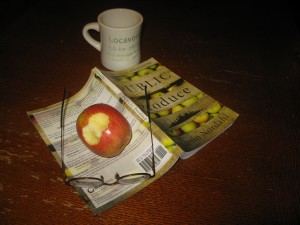The Locavore’s Bookshelf: Public Produce
As a landscape architect and city planner, Darrin Nordahl is in a unique position in regards to understanding and articulating the feasibility of urban agriculture in modern US cities. Unlike many authors, such as Micheal Pollan, Nordahl has first-hand experience with designing public landscapes in urban environments, and so he can see the viewpoints of those who favor of adding edible plants to urban landscapes and those who oppose the idea.
All of these facts work in Nordahl’s favor as he wrote Public Produce: The New Urban Agriculture. In it, he outlines the hows and whys of changing our public policies regarding food in the urban landscape. He makes a cogent argument that municipalities can and should take the lead in feeding the public through other means than the usual community garden. He suggests that cities can plant fruit and nut trees in public venues such as parks or city plazas. He tells stories of unused parking lots being turned into community gardens staffed by public employees where the food is available to everyone and anyone. He suggests, again, with straight reasoning behind his thoughts, that the traditional community garden plan is not sufficient to feed those in need, and that it is not only up to individuals or private charities to take up the slack, but that governments can and should step up and lead the way into a new way of integrating food into our daily lives in the 21st century and beyond.
I loved the ways in which Nordahl suggests to incorporate food into many different types of public venues, and I loved his arguments against the usual naysayers who declare that food plants have no business in the public view because they are unattractive and messy.
What I found lacking in the book, though, was a certain eloquence–while it is obvious to me that Nordahl is passionate about the subject and is more than knowledgeable, his writing style is a bit dry and lackluster. The stories he tells are factually interesting, but are told in such a way that they are bloodless and cold. There is a lack of human warmth in the book that made it very hard for me to read–which is odd because I can usually devour books of this type in days.
This book, though it is a mere 149 pages, took me over two weeks to read.
Compare that to the 450 pages in Michael Pollan’s The Omnivore’s Dilemma, which I read in less than a week.
But be that as it may, while the book is not an entertaining read that is easy to tear through, it has a worthy message and is filled with useful informatin, especially for people who are interested in helping alleviate the food inequity in our country.
And for that, it is quite worth slogging through the less than sparkling prose.
1 Comment
RSS feed for comments on this post.
Sorry, the comment form is closed at this time.
Powered by WordPress. Graphics by Zak Kramer.
Design update by Daniel Trout.
Entries and comments feeds.




Thanks for the review. It’s a fascinating and worthy topic. Nonfiction writers with sparkling prose are treasures, but even without that it’s sometimes worth working through. I’m glad to know about this book.
Comment by Adrianne — May 12, 2011 #